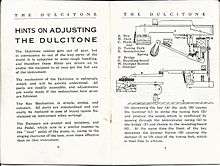Dulcitone
A dulcitone is a keyboard instrument in which sound is produced by a range of tuning forks, which vibrate when struck by felt-covered hammers activated by the keyboard. The instrument was designed by Thomas Machell of Glasgow in the 1860s, at the same time as Victor Mustel's organologically synonymous typophone,[1] and manufactured by the firm of Thomas Machell & Sons during the late nineteenth and early twentieth centuries.
Most of the early models are tuned to sharp pitch, or the diapason normal of a 435. Some of the late models use an action suspended on a system of leaf springs, which is considerably quieter than that illustrated.
Description

The dulcitone is a transposing instrument of the idiophone class; it sounds an octave higher than the standard (eight foot pitch) written pitch. It has a five octave written range from AA to a3 (sounding range from A to a4).
A significant feature of the dulcitone was its portability, a product of its lightweight and compact construction and the fact that the tuning forks (unlike, for instance, the strings of a piano) were not prone to going out of tune. However, the volume produced is extremely limited, and the dulcitone's part is frequently substituted by a glockenspiel.[2]
Two pieces scored for the dulcitone is Vincent d'Indy's Song of the Bells (1888) and Percy Grainger's "The Power of Rome and the Christian Heart" (1943). And The Maestro's books II
In 1911 there were 3 versions listed: Style B, with 3½ octaves in solid mahogany (polished Chippendale) or in solid oak (fumed) complete with folding stand, for £12; Style R - in mahogany or oak with 4 octaves for £15; Style F - in mahogany or oak with 5 octaves, for £18.
Surviving examples exist as far afield as New Zealand, where one is preserved in the Whittaker's Musical Museum.
The dulcitone continues to play a role in popular music. Arthur Jeffes of Penguin Cafe plays a dulcitone on several tracks of his 2012 album Insofar.[3]
Greg Cook of the Vagaband also plays dulcitone on their 2012 album Town and Country, most notably on the track "Send in the Cavalry".[4][5][6]
Enter Shikari use a dulcitone on their 2017 album The Spark (album), most notably on the track "Shinrin-yoku".[7]
See also
- Rhodes piano, technically an electrically amplified dulcitone.
- Celesta, similar to the dulcitone in that bars are struck by hammers.
Gallery
- Overall view of Dulcitone
- View of Dulcitone keyboard
- Name decal on inside of lid
 Front cover of users manual
Front cover of users manual Page 2 & 3 of users manual
Page 2 & 3 of users manual
References
- Mo, Sue. "Dulcitone". Sumo55 Websites & Multi Media Design. Retrieved 28 September 2016.
- The Ultimate Encyclopedia of Musical Instruments, ISBN 1-85868-185-5
- "SUNDOG: INSOFAR CD Album". Penguin Cafe web site. Retrieved 13 November 2012.
- "The Vagaband". Facebook.com. 2012-09-03. Retrieved 2016-03-12.
- "Home". Thevagaband.co.uk. 2015-02-02. Retrieved 2016-03-12.
- "The Vagaband - Town & Country". Americanrootsuk.com. Retrieved 2016-03-12.
- Enter Shikari (2018-10-03), Enter Shikari - Content 2.0 ; Documentary (Making Of The Spark) 2018, retrieved 2018-10-17